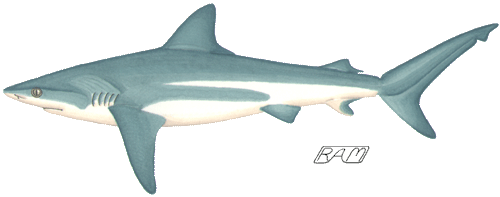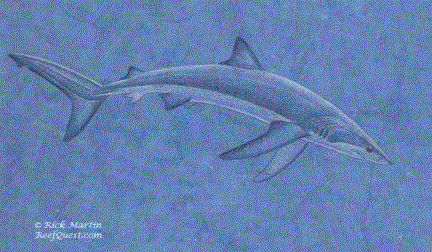40 Winks Under the Sea
Q: Several years ago the conventional wisdom on sharks seemed to be that all 'streamlined' species need to stay in constant motion in order to breathe. In the mean time, many of these species have been observed 'sleeping'. What was the reason for the initial misconception? Why do these sharks often congregate in specific caves.
- Thomas
Ithaca, NY
A: If you look at the head of any bony fish, you'll notice that the single gill opening is covered by a thick, bony plate (called an 'operculum'). What is not so obvious is that much of the posterior part of a bony fish's skull is jointed — made up of a mind-bogglingly complex suite of articulated bony elements which act as struts, levers, or catches. These elements, together with the operculum, are controlled by fairly powerful muscles which collectively serve to rhythmically expand and contract the throat and gill chamber, pumping oxygen-bearing water in through a bony fish's mouth and out through the gills.
Now look at a shark's head. The gill openings are separate — numbering between five and seven, depending upon species — with no operculum. The shark skull is relatively simple, a one-piece 'box' of cartilage not comprised of moveable skeletal elements. The flaps of skin separating the gills are thin and only weakly muscled. In short: sharks may be 'tough guys', but they've got whimpy gills. That's why it was long believed that sharks couldn't actively pump water over their gills and had to rely instead on 'ram-jet' ventilation, allowing oxygen-bearing water to passively flow in through the mouth and over the gills as an artifact of swimming.
It had been known for centuries that some sharks — such as nurse, wobbegong, angelsharks, and batoids such as skates and stingrays — spend most of their time lying motionless on the bottom actively pumping water over their gills. Not surprisingly, the throat and gill musculature of these sharks is unusually thick and powerful. Further, many bottom-dwelling sharks have well-developed spiracles, openings behind the eyes which act as accessory respiratory organs. But unlike these flattened, bottom grubbers, streamlined sharks such as the whalers and hammerheads have weakly-muscled gills and were believed to be condemned to a life of ceaseless prowl in order to maintain a steady flow of oxygen-bearing water over their gills.

Caribbean Reef Shark (Carcharhinus perezi)
In 1969, intrepid free diver Ramon Bravo discovered streamlined sharks apparently sleeping in a cave at Isla Mujeres, off the Yucatan Peninsula. Funded by the National Geographic Society, Eugenie Clark and co-workers traveled to Isla Mujeres in 1972 and 1973 to investigate this unprecedented phenomenon. Their field research revealed the species to be the Caribbean Reef Shark (Carcharhinus perezi) and that the water inside these caves have an unusually high oxygen content and reduced salinity, possibly due to freshwater upwellings from the Mexican mainland. The sharks remained in the caves for hours at a time, actively respiring by pumping water over their gills 20 to 28 times per minute. Clark speculates that the enhanced oxygen content may make breathing easier for the motionless sharks and may produce a narcotic effect the sharks enjoy. Since reduced salinity loosens the grip of skin parasites, Clark has suggested that the sharks may use these caves as 'cleaning stations', allowing shark suckers (remoras) to more effectively remove copepods, leeches, and other ectoparasites.
Although dubbed 'sleeping sharks', whether these animals actually sleep in the caves is uncertain. Divers report that the eyes of these sharks follow them intently as they move about inside the cave, suggesting that the sharks are not truly asleep. Sleep in vertebrate animals is characterized by profound changes in the electrical signature of brain activity, and it seems likely that brain waves could be monitored in the field electronically from a distance (to the best of my knowledge, this has not yet been done). How sharks originally locate these caves is uncertain, but individual sharks seem to return to the same caves time and again. Clark has suggested that the sharks may find the caves by electrical cues sensed by their ampullae of Lorenzini (this seems unlikely because — given the amount of background 'static' in the marine environment — the functional range of the ampullae is limited to a foot or so). To date, at least four and possibly five species of whaler shark are known to enter the caves at Isla Mujeres: the Caribbean Reef, Tiger (Galeocerdo cuvier), Lemon (Negaprion brevirostris), Blue (Prionace glauca), and probably the Bull (Carcharhinus leucas).

Elsewhere, other species of streamlined shark have been reported lying motionless in caves for extended periods. Banded Houndsharks (Triakis scyllium) have been observed in caves in Izu Oceanic Park, Japan, piled atop one another like beer-sodden near-fatalities of an all-night Frat Party. The Whitetip Reef Shark (Triaenodon obesus) is well-known for its habit of lying motionless in caves for hours at a time during daylight hours at widely scattered locations throughout the tropical Indo-Pacific; Whitetip Reef Sharks at Cocos Island, Costa Rica, seem to have done away with caves altogether, their bodies stacked like cordwood on the exposed, sandy bottom. Solitary Lemon Sharks in Bimini, Bahamas, have been reported lying exposed on the bottom for extended periods. I have observed Grey Reef (Carcharhinus amblyrhynchos) and Blackfin Reef (Carcharhinus melanopterus) Sharks lying quietly on the sand between bommies (coral heads) for hours at a stretch at several locations throughout the tropical western Pacific.
These sharks all seem to have been uninjured and healthy when they were observed lying on the bottom. What's going on here? Resting away from view in caves is one thing, but how could scientists be so wrong when sharks frequently lie on the bottom right out in the open? If they're not sick or injured, what ARE these sharks doing? No one really knows, but there are some tantalizing clues.
As part of an ambitious ten-year project on the role of the Lemon Shark in the shallow waters of Bimini, a University of Miami team led by Samuel Gruber has studied numerous aspects of Lemon Shark biology, both in the field and in the laboratory. Gruber's team confirmed that adult Lemon Sharks lying quietly on the bottom for extended periods actively pump water over their gills. They noted that the sharks typically prop themselves up on their pectoral fins and face into the prevailing current; these behaviors may help them breathe easier. Manometry experiments in Gruber's laboratory have revealed that, even facing into the current and propped up on their fins, juvenile Lemon Sharks use about 9% more oxygen actively respiring than they do if swimming in the water column and relying on passive ram-jet ventilation. In other words, a Lemon Shark has to work harder lying on the bottom than it does swimming. So, whatever they're doing, it ain't restful.
My feeling is that streamlined sharks that stop swimming and lie on the bottom — whether on exposed sand or in caves — do so for social reasons. Perhaps a shark lying in plain view on the bottom 'wants' to be seen. Although a number of shark species are known to have well-defined home ranges, they do not seem to be territorial (that is, defending a precise geographical area for their exclusive use). Possibly lying exposed on the sand allows a shark to announce its species identity and availability for mating ("Yo, Baby: check out these fins!"). Mating is, after all, one of the best reasons for investing some heavy breathing! As for sharks congregating in caves, perhaps they, too, gather as some prelude to mating (although mating behavior clearly associated with cave-dwelling has not been documented). They may be hanging out in a relatively predator-free area until twilight or after dark, then go their own way in search of food (a strategy known as 'refuging'). In certain locations, the sharks may well be getting cleaned or 'high', as Eugenie Clark suggests. But perhaps they simply enjoy the tactile stimulation of bodily contact. Or maybe they just like one another's company.
Who knows? Maybe you will be the one to report a crucial observation and help solve the mystery of 'sleeping' sharks. But if you encounter one lying on the bottom, let a sleeping shark lie. Their gills may be wimpy, but their jaws certainly are not. Better safe than sushi!
